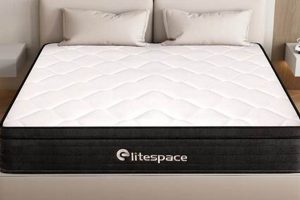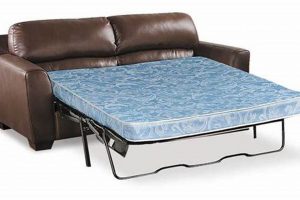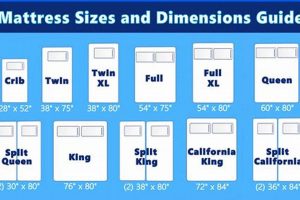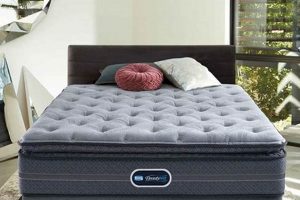This type of sleep surface combines the conforming properties of specialty foam with the support and motion isolation characteristics of individually wrapped springs. The design aims to provide pressure relief and minimize disturbances from movement during sleep. The core component involves hundreds of fabric-encased coils that operate independently, responding to localized pressure rather than transferring it across the entire mattress surface.
The inherent structure offers significant advantages for couples or individuals seeking enhanced sleep quality. The individually wrapped coils contour to the body, promoting spinal alignment and reducing pressure points, potentially alleviating discomfort in the back, shoulders, and hips. Furthermore, the independent action of the springs minimizes motion transfer, meaning movements on one side of the bed are less likely to disturb a partner on the other. Historically, this approach represents an evolution in mattress design, blending the best features of innerspring and foam technologies.
The following sections will delve into specific aspects of this sleep system, including its construction, material composition, performance attributes relating to comfort and support, and its relative advantages and disadvantages in the broader mattress market. Further discussion will cover ideal sleeper types, maintenance recommendations, and factors to consider when making a purchasing decision.
Essential Considerations for the Prospective Buyer
This section provides practical guidance when evaluating a sleeping surface that incorporates individually encased springs and specialized foam layers. Careful consideration of these factors will aid in selecting a product that aligns with individual needs and preferences.
Tip 1: Evaluate Coil Count and Gauge: Higher coil counts generally indicate enhanced support and contouring. Gauge refers to the thickness of the steel; lower gauge numbers signify thicker, firmer coils. Determine the optimal balance based on body weight and preferred firmness level.
Tip 2: Assess Foam Density and Type: Memory foam density impacts durability and responsiveness. Higher density foam tends to offer greater support and longevity. Consider the type of foam used (e.g., gel-infused, open-cell) for temperature regulation properties.
Tip 3: Scrutinize Edge Support: Robust edge support prevents sagging and maximizes the usable sleep surface. Look for reinforced edges or perimeter coils that maintain firmness along the mattress’s perimeter.
Tip 4: Review Trial Periods and Warranties: A generous trial period allows for in-home testing and ensures satisfaction. A comprehensive warranty protects against manufacturing defects and premature wear.
Tip 5: Consider Sleeping Position: Side sleepers typically benefit from thicker comfort layers for pressure relief, while back and stomach sleepers may prefer a firmer surface for spinal alignment.
Tip 6: Research Independent Reviews: Consult reputable third-party review sites to gain insights into real-world performance and durability. Pay attention to recurring themes and potential issues reported by other users.
Tip 7: Inquire About Certifications: Look for certifications such as CertiPUR-US, which indicates that the foam components meet specific standards for emissions, content, and durability.
Implementing these considerations facilitates an informed decision, leading to the selection of a sleep system that provides optimal comfort, support, and longevity.
The subsequent sections will explore advanced features and compare the specific product to alternative options available in the market.
1. Motion Isolation
Motion isolation is a primary performance characteristic directly attributable to the internal architecture of a mattress incorporating individually encased springs. This design seeks to minimize the transfer of movement across the sleep surface, thereby enhancing sleep quality for co-sleepers. The following details outline key facets of motion isolation within the context of this particular type of mattress construction.
- Independent Coil Action
Each spring within the system operates independently of its neighbors. This independence prevents force applied to one area from propagating outward, mitigating the ripple effect that occurs in traditional interconnected innerspring systems. For instance, when one partner shifts positions during sleep, the localized compression of the springs under their weight does not significantly impact the springs beneath the other partner, thus minimizing disturbance.
- Fabric Encapsulation
Each coil is individually wrapped in a fabric pocket, further isolating its movement. This encapsulation acts as a dampening mechanism, absorbing energy and preventing it from transmitting laterally across the mattress. Consider a scenario where a pet jumps onto the bed; the encapsulated coils directly beneath the pet absorb the impact, preventing a widespread jolt that would otherwise disturb sleeping partners.
- Material Dampening
The foam layers above and below the coil system contribute to motion isolation by absorbing and dissipating energy. These layers, often composed of memory foam or latex, possess inherent damping properties that further reduce the transmission of movement. A glass of water placed on one side of the mattress will experience less disturbance from movement on the opposite side due to this combined dampening effect.
- Edge Support Construction
While primarily intended for edge support, reinforced perimeter coils can indirectly enhance motion isolation. A stable edge reduces overall mattress sway and movement, preventing motion from transferring to the edges of the bed, which are often close to the sleeping partner. This construction element further contributes to a stable and undisturbed sleep environment.
The combined effect of independent coil action, fabric encapsulation, material dampening, and edge support construction in such mattresses is to significantly reduce motion transfer. This attribute is particularly beneficial for individuals who are easily awakened by movement, contributing to a more restful and uninterrupted sleep experience for both partners sharing the bed.
2. Conforming Support
Conforming support, in the context of mattresses featuring individually encased springs, refers to the ability of the sleep surface to adapt to the unique contours of the human body. This characteristic is essential for pressure relief, spinal alignment, and overall sleep comfort. The specific architectural design and material composition contribute significantly to this feature.
- Independent Coil Articulation
The defining element is the independent response of each encased coil. Unlike traditional interconnected springs, these coils compress and rebound individually, adapting to localized pressure. For instance, a side sleeper will experience greater compression in the shoulder and hip areas, allowing those regions to sink in while maintaining support for the torso. This localized response minimizes pressure points and promotes a more natural spinal curvature.
- Memory Foam Integration
The inclusion of memory foam layers enhances the conforming properties. Memory foam reacts to body heat and weight, gradually molding to the sleeper’s shape. This process distributes weight more evenly across the mattress surface, reducing stress on joints and pressure-sensitive areas. Consider a person with chronic back pain; the memory foam conforms to the spine’s natural curves, providing support and alleviating discomfort.
- Zoned Support Systems
Some designs incorporate zoned support, where coil firmness varies across different sections of the mattress. Firmer coils in the lumbar region provide additional support for the lower back, while softer coils in the shoulder area offer enhanced pressure relief. This tailored approach optimizes spinal alignment and caters to the specific needs of different body regions. The aim is to provide optimized support where it is needed most.
- Surface Material Compliance
The uppermost layers, often composed of quilted fabric or specialized foams, contribute to the initial feel and conforming ability. These materials offer a degree of immediate comfort and contouring, adapting to the sleeper’s body upon initial contact. For example, a plush quilted top layer provides a soft, enveloping sensation, complementing the deeper support provided by the coils and memory foam. This creates a balanced sensation of both comfort and support.
These elements independent coil articulation, memory foam integration, zoned support systems, and surface material compliance work synergistically to deliver conforming support. The resulting sleep experience is characterized by reduced pressure points, improved spinal alignment, and a more comfortable and restorative rest. It is a critical element in achieving long-term comfort and preventing pain and discomfort during sleep.
3. Edge Reinforcement
Edge reinforcement is a structural design element implemented in many mattresses, including those with individually encased springs, to bolster stability and expand the usable sleep surface. Its presence directly impacts the lifespan, comfort, and overall functionality of the mattress. The following delineates key aspects of edge reinforcement in relation to mattress construction featuring pocketed coils.
- Perimeter Coil Support
This method involves the strategic placement of thicker gauge coils around the perimeter of the mattress. These robust coils provide greater resistance to compression, preventing the edges from sagging under weight. Consider an individual consistently sitting on the edge of the bed; without perimeter coil support, this repeated pressure would eventually lead to edge deformation and reduced support. Such deformation compromises the structural integrity of the entire mattress over time.
- Foam Encasement Systems
Edge support can also be achieved through the use of high-density foam rails that encircle the coil system. These foam rails offer a solid, stable border, preventing roll-off and maximizing the usable sleep area. Imagine sharing a bed with a partner; foam encasement prevents the feeling of falling off the edge, particularly for those who sleep close to the periphery of the mattress. This ensures a more secure and comfortable sleep environment for both individuals.
- Reinforced Edge Zones
Some designs utilize specific edge zones, where a combination of thicker coils and denser foam is strategically placed to provide enhanced support. These zones are often located at the areas most susceptible to compression, such as the edges used for sitting or getting in and out of bed. For example, if an elderly individual relies on the edge of the mattress for support when rising, a reinforced edge zone would provide the necessary stability and prevent the mattress from collapsing under their weight.
- Hybrid Support Structures
Certain mattresses integrate a hybrid approach, combining perimeter coils with foam encasement to achieve optimal edge support. This multifaceted approach provides a more comprehensive and durable solution, addressing both vertical and horizontal compression. Visualise a mattress being moved or rotated; a hybrid support structure ensures that the edges maintain their shape and integrity, even under stress. This contributes to the long-term performance and aesthetic appeal of the product.
The presence of adequate edge reinforcement translates to a more durable, supportive, and comfortable sleeping experience. It not only maximizes the usable sleep surface but also prevents premature sagging and maintains the structural integrity of the mattress over time. This feature is particularly relevant in mattresses with pocketed coils, as it complements the motion isolation properties and enhances the overall performance of the sleep system.
4. Temperature Regulation
Temperature regulation within a mattress featuring individually encased springs is a critical factor influencing sleep comfort and overall rest quality. Overheating during sleep can disrupt sleep cycles and lead to restlessness. The design and materials employed in these mattresses aim to mitigate heat retention and promote airflow, establishing a more conducive sleep environment. Several design elements contribute to this regulatory process.
The open structure of the coil system allows for enhanced air circulation compared to solid foam mattresses. The spaces between the individual coils provide pathways for heat to dissipate, preventing the accumulation of body heat. Furthermore, manufacturers often incorporate breathable materials in the comfort layers, such as open-cell memory foam or gel-infused foam, which further facilitate heat transfer away from the body. As an example, an individual residing in a warm climate may find that a pocketed coil mattress with breathable foam layers reduces nighttime sweating and enhances comfort. Conversely, a mattress lacking these features may trap heat, leading to discomfort and disrupted sleep. The selection of appropriate materials and construction techniques is paramount in achieving effective temperature regulation. The selection of appropriate materials and construction techniques is paramount in achieving effective temperature regulation.
Ultimately, effective temperature regulation in a mattress with individually encased springs is contingent on the careful balance of materials and design. While the coil system inherently promotes airflow, the selection of breathable foams and specialized cooling technologies further enhances this effect. The understanding of these principles allows consumers to make informed decisions, selecting products that address their individual needs and preferences. This also ensures a more comfortable and restful sleep, regardless of the ambient temperature. However, challenges remain in accurately quantifying the cooling effectiveness of different mattress designs and materials, requiring further research and standardized testing methods.
5. Durability Assessment
The long-term performance of mattresses that incorporate individually encased springs is directly linked to a thorough durability assessment. This assessment involves evaluating multiple factors that influence the mattress’s ability to withstand prolonged use and maintain its structural integrity and comfort properties.
- Coil Gauge and Material Composition
The gauge (thickness) of the steel wire used in the coils and the quality of the steel alloy are primary determinants of coil durability. Lower gauge numbers indicate thicker, more robust coils that are less prone to deformation or breakage over time. The type of steel also plays a role, with higher-quality alloys exhibiting greater resistance to fatigue and corrosion. For example, a mattress utilizing low-gauge, high-carbon steel coils will likely exhibit superior long-term support compared to one with thinner, lower-grade coils. The degradation of coil support compromises the intended pressure relief and motion isolation characteristics of the mattress.
- Foam Density and Resilience
The density of the foam layers (memory foam, polyfoam, or latex) significantly impacts their resistance to compression and degradation. Higher-density foams retain their shape and supportiveness for longer periods, while lower-density foams are more susceptible to sagging and indentation. Resilience, the ability of the foam to recover its original shape after compression, is another critical factor. A mattress with high-density, resilient foam layers will maintain its comfort and support properties for a longer duration than one with lower-quality foams, which are prone to developing permanent body impressions.
- Fabric Quality and Stitching Strength
The quality of the fabric used in the mattress cover and the strength of the stitching seams influence the overall structural integrity and resistance to wear and tear. Durable, tightly woven fabrics are less prone to tearing, stretching, or pilling. Strong stitching seams prevent the mattress from unraveling or losing its shape over time. A mattress with a high-quality cover and reinforced stitching is more likely to withstand years of use without exhibiting signs of damage or degradation. Fabric and stitching failures compromise the integrity of the entire mattress.
- Construction and Assembly Techniques
The manner in which the various components of the mattress are assembled, including the method of bonding the foam layers to the coil system and the overall structural design, affects its long-term durability. Proper lamination techniques prevent delamination of the foam layers, while a well-designed support structure ensures even weight distribution and prevents premature sagging. A mattress constructed with meticulous attention to detail and employing robust assembly techniques is more likely to withstand the stresses of daily use and maintain its original shape and support characteristics.
The various aspects of the “Durability Assessment” work interdependently to influence its longevity. Poor-quality coils can lead to premature sagging, while low-density foam can contribute to body impressions. A mattress that successfully integrates durable components with robust construction techniques will provide a more lasting and satisfactory sleep experience.
Frequently Asked Questions
This section addresses common inquiries regarding mattresses that feature individually encased springs, providing detailed and factual responses to assist in informed decision-making.
Question 1: What is the typical lifespan of a pocketed coil mattress?
The expected lifespan varies depending on factors such as coil gauge, foam density, and usage patterns. However, a well-constructed mattress of this type generally lasts between seven to ten years.
Question 2: Are pocketed coil mattresses suitable for individuals with back pain?
The conforming support offered can alleviate pressure points and promote spinal alignment, potentially reducing back pain. However, individual results may vary, and consulting a medical professional is advised for specific conditions.
Question 3: How does a pocketed coil mattress compare to a memory foam mattress?
Pocketed coil mattresses typically offer greater breathability and bounce compared to memory foam mattresses. Memory foam excels in pressure relief and motion isolation, while pocketed coils provide more robust support.
Question 4: What is the ideal firmness level for a pocketed coil mattress?
The optimal firmness level depends on individual preferences and sleeping position. Side sleepers generally prefer a softer mattress, while back and stomach sleepers may benefit from a firmer surface.
Question 5: How do pocketed coil mattresses address motion transfer?
The individual encapsulation of each coil minimizes the transfer of movement across the mattress, preventing disturbances caused by a partner’s movements during sleep.
Question 6: What maintenance is required for a pocketed coil mattress?
Regular rotation of the mattress is recommended to promote even wear. Spot cleaning spills promptly is essential. The manufacturer’s instructions should be consulted for specific care guidelines.
In summary, a carefully chosen pocketed coil mattress can deliver significant benefits in terms of support, comfort, and durability. Understanding the factors that influence its performance allows for a selection that aligns with individual needs and preferences.
The subsequent sections will address related topics, offering additional insights for the prospective buyer.
Synthesis
This exploration into the characteristics and considerations surrounding a mattress with independently encased springs reveals a complex interplay of design, materials, and performance attributes. The core benefit centers on providing targeted support and minimizing motion transfer, contributing to enhanced sleep quality. Understanding coil gauge, foam density, and edge support construction are important factors for prospective buyers to evaluate before making a decision.
Ultimately, selecting a sleeping surface is a personalized endeavor. Individuals must weigh the advantages against specific needs and preferences. Further research into independent reviews and certifications can provide valuable insights, facilitating a decision aligned with long-term comfort and well-being. The information presented here provides a foundation for informed and strategic evaluation.







